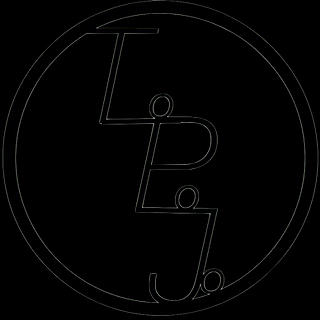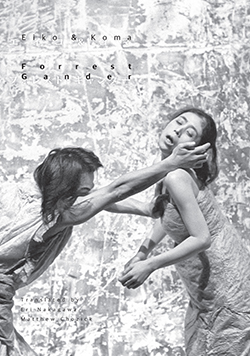Dance Fractals in Language: Interview with Eri Nakagawa and Matthew Chozick, Translators of Forrest
- Tokyo Poetry Journal
- May 5, 2019
- 7 min read
––––Jordan A. Y. Smith
[interview + poem by Gander / translation by Nakagawa and Chozick]
Dancers Eiko Otake and Koma Otake were born in Japan and lived there until 1976, when they moved to NYC to pursue their dance career as a duo––which led to a stellar four decades plus change during which they have performed at venues including the Museum of Modern Art (MoMA) and the Whitney Museum of American Art. Their fame abroad––evidenced by numerous prizes abroad, including a MacArthur Fellowship and a Scripps Award––has now exceeded that in their native Japan, though they began by training there with many of the legendary founders of butoh style (or school, or genre…see our introduction to Tokyo Poetry Journal Volume 6, which devotes some space to hashing out that question). Eiko and Koma developed their own style, albeit one visibly marked by the tempo, earthly-corporeal presence, and figurative abstractions of butoh progenitors. Their dances come in various lengths—from a few minutes to a full working day (post-New Deal and prior to neoliberalization)—all of them rivet and absorb audiences.
Their circle of collaborators, admirers, and friends grew over the decades, and eventually it came to include the poet, Forrest Gander. Gander is best known to us at TPJ due to the well-known fact that his career reached a soaring pinnacle when he became a member of the Board of Advisors for Tokyo Poetry Journal. But in between and around that he also accomplished a few other things that probably bear repeating here.
Many in the international poetry community know Gander as a highly accomplished and profoundly moving poet, a scholar of comparative literature, a master of translation, and a supporter of the field of poetry as a whole, teaching scores of literary luminaries in the MFA program in Literary Arts at Brown University (and at Harvard University before that). Gander has been a finalist for the Pulitzer Prize and the National Book Critics Circle Award, and is known for his translations of Pablo Neruda, Raúl Zurita, and many Latin American writers, as well as for co-translation of Kiwao Nomura (with the indomitable Kyoko Yoshida). Gander’s edited volume of Gozo Yoshimasu translations, Alice Iris Red Horse (New Directions 2016), broke ground as “a book in and on translation,” pairing some dozen translations by different translators with essays about their experimental translation process. Most recently, his book Be With earned the Pulitzer Prize in Poetry (April 2019), confirming the sturdy bedrock beneath his already impressively thick regolith of accomplishments (Gander is actually educated as a geologist, unlike yours truly who had to dig deep for that last metaphor).
Eiko and Koma met Forrest Gander in the early 1990s, so their friendship is now pushing thirty. Gander’s sustained engagement with the dancers resulted in a short book of poetry titled after them: Eiko & Koma (New Directions 2013). The poems are “a kind of translative act” (as the translators say in the short interview below), a kind of ekphrasis of motion; at other times, they seem to meditate philosophically on the interpretation of the motions, all suffused by the marvel of two humans intimately relating to each other in body and spirit.
And here in Tokyo, two powerhouse translators became intensely interested in Gander’s volume: University of Tokyo faculty member and Ph.D. candidate Eri Nakagawa and Temple University (Tokyo) professor, translator, and television personality Matthew Chozick. Their interest was based both on the poetry and the dance that motivated it. The book just been released internationally by Awai Books is thus a case of "reverse-importation" (gyaku-yunyuu) of two Japanese dancers who made a name for themselves abroad and of Forrest Gander who has been drawing Japanese poetry into the English translationscape, yet whose poetry is still relatively unavailable. Nakagawa and Chozick’s translation is astonishingly smooth while extremely faithful; their volume is a rich case study in what poetry translation can accomplish.
We managed to catch up with the two of them to discuss their bilingual edition complete with beautiful photography of Eiko and Koma in performance and diagrammatic explanations of the dance.
(See more dances and readings via links at the end of the interview...)
Can you tell us what led to the choice of this particular volume from Gander’s oeuvre?
We hope this volume is just a starting point, and we selected it because it showcases Gander’s precision, originality, and buoyancy along with the fascinating Japanese subjects of Eiko and Koma. Aside from how amazing the original is to read and how we felt it needed to be more widely available, we enjoyed how the poems are recursive and fractal-like, especially from the perspective of translators. In a kind of translative act, Gander transposes the physical movements of Eiko & Koma into language; and underpinning that process is Eiko & Koma’s own idiom of the body, which also involves the translation of ideas and emotions.
What poems pushed your translatorly creativity the most? How?
The intertextuality in “Road-Entering” was a challenge for translation, since the references are not as well known in Japanese as in English. But perhaps more than anything else, the enjambment throughout pushed our creativity.
Yes—I love what happens with your faithful renderings of enjambment in the original. Can you talk about your strategy for dealing with them in the translation?
Since the sentence structure in Japanese is so different from English, we couldn’t identically replicate the original text’s enjambment. As a compromise we tried to determine what each particular line break achieved — whether adding a double meaning, accelerating or decelerating a sense of movement, highlighting an idea — and we tried to offer something in Japanese akin to that, which was a huge challenge and source of pleasure.
It was really a remarkable accomplishment in translation. I wonder about your process. In particular, this seems like it would be a complex project—in addition to managing the relationship of the English and Japanese, you had the added factor of working with poems that engaged intimately with dance performances.
Did the two of you act out any of the dances or pantomime the movements as you were trying to render the dance descriptions? Or did you translate based primarily on the semantics and other linguistic aspects of the English? In other words, how much was the dance directly involved in your translation?
Any excuse to dance is a good one! We received many funny looks in our neighborhood office/coffeeshop for pantomiming. But we had different, complementary strategies for visualizing the movements during translation. I (Matthew) tried to translate poems based on semantics and diagrams/photographs in the original book, whereas I (Eri) liked to check the poems against videos of Eiko & Koma.
Co-translating can do many things to two humans. What effect did it have on the two of you working as a team? Are you still friends? Most importantly, are you still Facebook friends?
We have yet to unfriend each other on Facebook! Co-translation was new to both of us, and it was a lot of fun collaborating. Twice a month we’d each select a poem, translate it, and then meet up to check them and discuss their nuances. You probably wouldn’t be able to guess who originally did what, since we spent a lot of time editing everything at the end and matching up the tones and diction.
Have Eiko and Koma also seen these translations? If so, did they offer any thoughts or feedback?
Eiko offered advice on adding a couple of English loanwords (in the katakana syllabary), since they’d be easier for Japanese to understand than Chinese characters.
I love it—her concern with ease of understanding, even though some might see her work anything but simple to interpret. But maybe that’s the appeal too—the simultaneous experience of simplicity and complexity… So what plans do you have for releasing the book? Any bilingual readings planned? Dance performances?
In Tokyo we’re excited to hold a bilingual reading in late August [2019] at Museum of Modern Art Tokyo with Gander, and it’ll showcase a new performance by Eiko. We’ll definitely keep you up to date on the details!
How many vacuums does it take to clean a bryophitic carpet?
We’ll confirm that with Gander!
Awesome. Let’s ask him in August—a fine season for mosses in Japan.
Links:
Videos of Gander reading from the English of E&K:
Videos of E&K Dances:
Note: Some of Gander’s readings in these early videos are of earlier versions of the poems. Some of Eiko & Koma’s dances differ each performance, so the dances that inspired Gander’s poetry often differ from the descriptions. The ephemerality of dance is one of its primary features, one that requires the viewer to be present in body just as the dancers are. The fact that the art embodies ephemerality and reminds us of the ephemerality of the body itself is perhaps the form’s most potent message.
BREATH
Early draft of the world. Or
has all that came before
made them its repository? Grove of slash.
They are. Flowerless dirt.
Windmoan over leafy mound strewn
with two human forms,
veined and branched. To
become what one was: that
never happens. But now the
ground wrinkles with their languorous
pandiculation. Crescent
shoulder blade and blue
bays between expanding,
contracting ribs. That the
recognizable mammalian
familiarity recedes in
exposures, in dilated time.
Become one, inhuman, beyond
animal. Are they.
Translation into Japanese by Nakagawa and Chozick:
「息」
世界の初期草案.あるいは
それまでのすべてが 彼等を作り
自らの貯蔵庫に?切り屑の木立.
彼等は.花無しの土.
嘆きの風が吹き
葉の山を散らす
二つの人がたは
脈打ち枝分かれする.かつての
姿に戻るために:それは
決して起こらない.だが今
地面に皺が寄る
彼等の気だるい
伸びに合わせて.三日月形の
肩甲骨と蒼い
入江がいくつも見える
拡張,収縮する肋間.それは
見慣れた哺乳類の
親近性が失われていく
露出の膨張する時間.
一つになる,人を脱し,動物を
超えて.そう,彼等は .








Comments